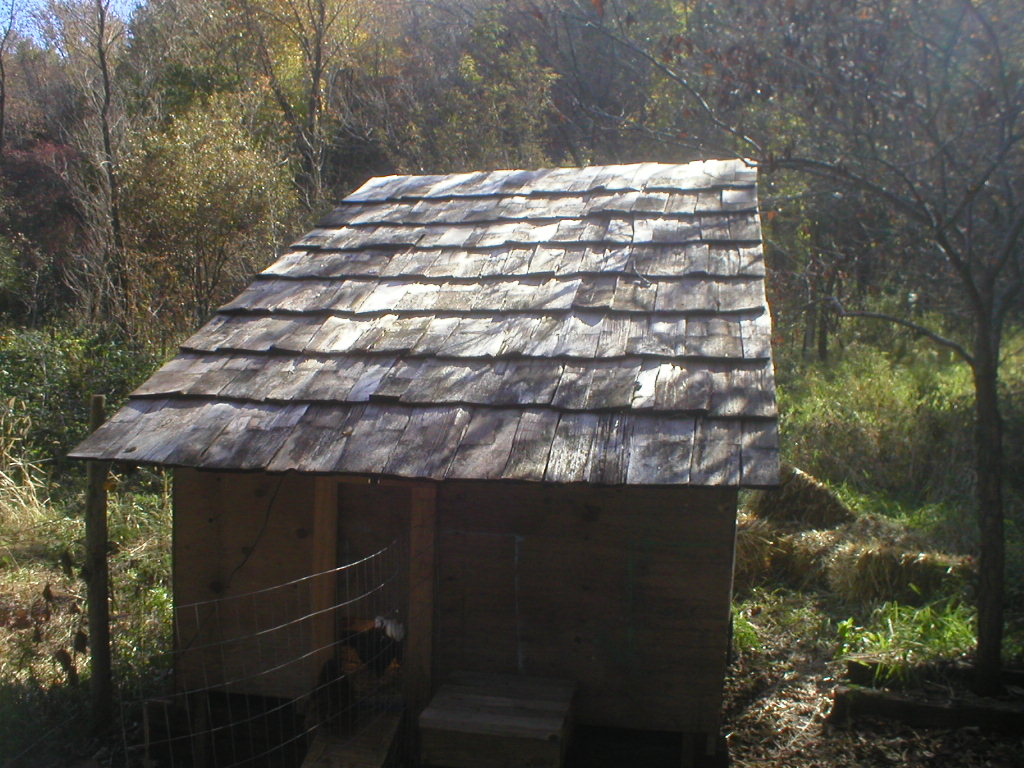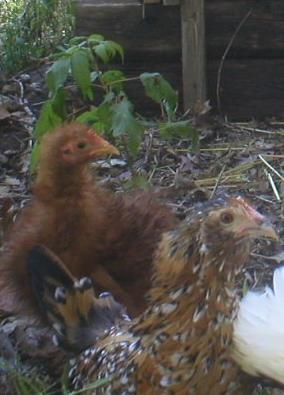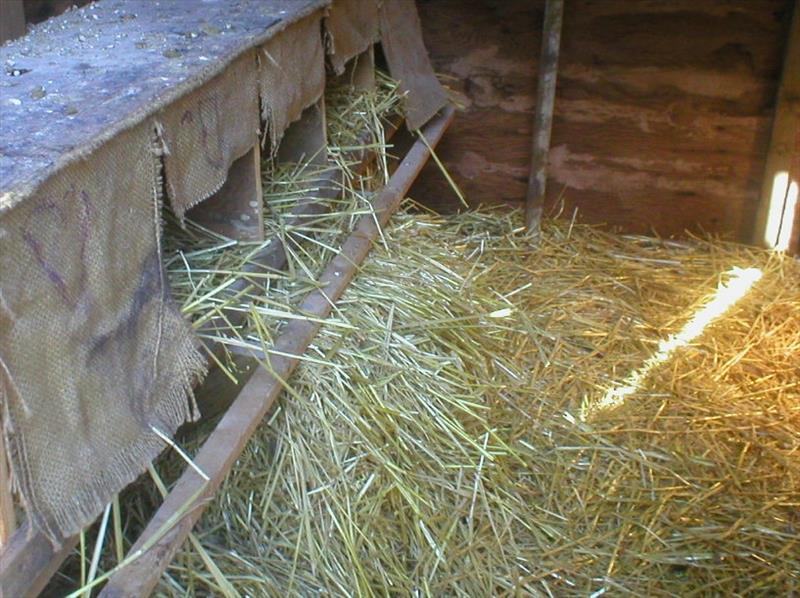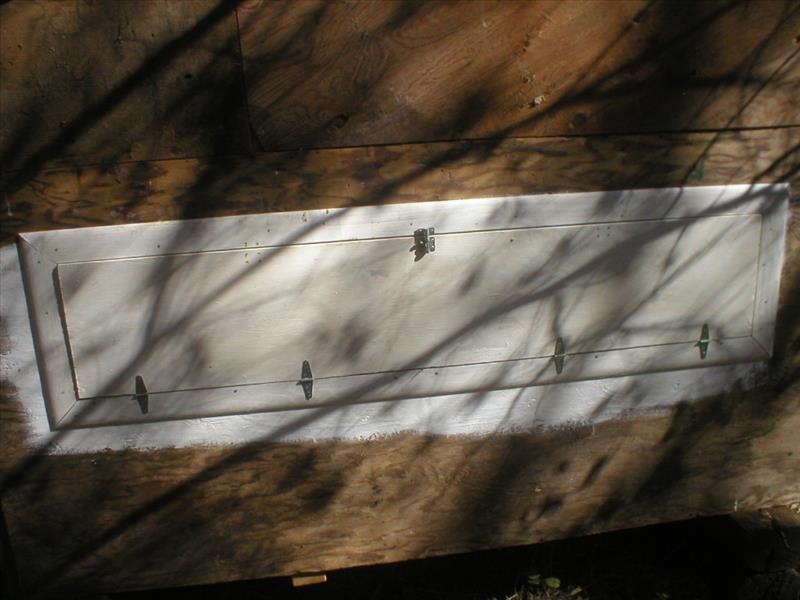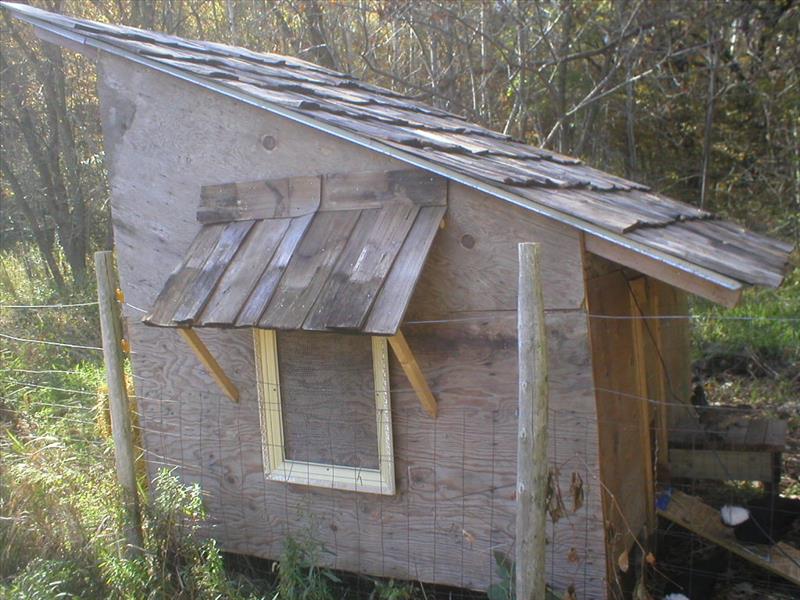Word >
Chicken Coop for the Soul
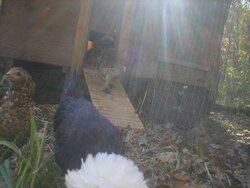 Copper, Cooper, and Lindsay LoHen emerge angelically from their home.
Copper, Cooper, and Lindsay LoHen emerge angelically from their home.
A chicken coop? This was questionable because the coop was such an odd looking structure. The boxy thing was made almost entirely of junk, but it did contain chickens. With some distance and a different perspective, and particularly in the evening under tree shadows, it looked lovely, vaporous, and metaphorical. Stories were in the box. The box contained the spirits of physical chickens, and the spirit of something else, a sort of dimly shining thing like wire suddenly unbinding from my wrists. I built a chicken coop.
The coop was full of strangely twisted and odd-sized lumber, rusty screws, a banister, pieces of a violently disassembled piano, rusty chicken wire salvaged from the woods, an ornate picture frame losing its gilding, part of a book shelf, hinges from an abandoned wagon, sheets of plywood pulled up from the old barn floor and cemented over with dried manure, lots of used nails tapped straight with a hammer, chunks of assorted weird stuff, and $19.27 worth of new hardware. The project took a long time, because my self-made mission was to work with the materials available and I couldn’t allow myself to use any new wood whatsoever. Therefore, I couldn’t construct in the standard, straightforward way. I was taking the artist Paul Klee’s approach of adapting myself to the contents of the paintbox, or in this case, the barn full of useless stuff. There were many odd angles and strange connections, such as the bent piece of rebar woven between rafters and mounted to the wall with deck brackets. The spaces between studs were more like trapezoids than regular rectangles.
But I created a little chicken art house. It was handsomely, quaintly covered with cedar shakes. Our country home, Windfall, used to be roofed with them, and many were recoverable from the rotting shingle pile. It had an exterior egg door so you could reach into the nesting boxes from the outside. There was a self-opening entry door to facilitate walking in with your arms full of 50 pound feedbags or crushed oyster shell. I made it that way accidentally, because the chicken coop leaned south. There was a bay window and on the outside I put the picture frame around it, so when the chickens looked out they appeared to be portraits of chickens. The tricolored walls were the result of using up leftover paint I found in cans so rusty I had to punch the lids in with a sledge. I made a small entry and exit door out of the music desk, the board from the piano for propping sheet music. It was hinged at the bottom so that, when open, it doubled as a ramp. I had to saw grooves in it because at first the varnish was too slick, and the chickens zipped out the door like timid kids on a slide. They were flustered. I even built them a little deck to lounge on. Maybe they could barbecue. Soy burgers, not chicken. All that was needed were some very small Adirondack chairs.
But I created a little chicken art house. It was handsomely, quaintly covered with cedar shakes. Our country home, Windfall, used to be roofed with them, and many were recoverable from the rotting shingle pile. It had an exterior egg door so you could reach into the nesting boxes from the outside. There was a self-opening entry door to facilitate walking in with your arms full of 50 pound feedbags or crushed oyster shell. I made it that way accidentally, because the chicken coop leaned south. There was a bay window and on the outside I put the picture frame around it, so when the chickens looked out they appeared to be portraits of chickens. The tricolored walls were the result of using up leftover paint I found in cans so rusty I had to punch the lids in with a sledge. I made a small entry and exit door out of the music desk, the board from the piano for propping sheet music. It was hinged at the bottom so that, when open, it doubled as a ramp. I had to saw grooves in it because at first the varnish was too slick, and the chickens zipped out the door like timid kids on a slide. They were flustered. I even built them a little deck to lounge on. Maybe they could barbecue. Soy burgers, not chicken. All that was needed were some very small Adirondack chairs.
|
We enjoyed the fresh banty eggs. Cooper didn’t like giving hers up, and would growl at you. Maddie would lay hers in crazy places like the watering dish or, one time, balanced on the handle of the trash can where we kept the food safe from critters. The coop was well built, though, and even if salivating rats with eyes on the grain – or weasels with more sinister intentions – tried gnawing their way in, I had stapled hardware cloth three feet up on all the insides. The wire would deny them the pleasure.
|
|
Life with chickens was much like life without chickens, except I had a relationship – or six relationships – that came unexpectedly. Who knew that chickens have individual personalities? It took me awhile to learn their names. My nieces named them at first, but a couple of the names required changing to match the characters. “Maggie” was right on the mark. She was a matronly hen with just a touch of girlish curiosity, preventing her from being a Margaret. “Copper” was appropriate, because her feathers were the precise color of the stripped, time-burnished electrical cord I used to fashion the heat lamp hangers. A chicken renamed “Cooper,” who was a twin sister of Copper, felt most at home in the bookshelf nesting boxes. “Maddie” was truly insane. She had a habit of standing on a dead electric fence, wobbling like a tightrope walker. She’d hold this precarious perch even in a downpour. I frequently tucked her into bed, that is, placed her on a narrow banister next to the rest of the family.
|
We lost Lindsay LoHen. She would occasionally party all night in the woods, and wander in at sunrise all bleary-eyed with the chicken equivalent of a hangover. She was the victim of her own lifestyle. The sixth chicken wouldn’t stick a name to save her soul, but at last seemed content to be called Sara’s Chicken. She liked to jump in your lap. All of them were friendly, and ran like long-legged puppies to greet you, even Maddie, who at first would run perpendicular of the pack and then zigzag her way to find you.
The chickens were fun to have around. A fox killed them.
They had nice outfits, too. Maggie and Maddie wore boots, little feather tufts that covered their feet and matched their pepper-speckled creamy tops. Copper and Cooper wore rusty red feathers that changed colors in the sunlight. Lindsay LoHen and Sara’s Chicken were elegant in black, and had crests of white feathers that looked like vintage frou frou hats. My favorite was Copper, who looked like she slept in her clothes. Her feathers were punkish and scraggly to match her voice. The sounds that came out of her were unlike any chicken sounds I’ve ever heard. She sounded exactly like a grunge rock singer with a sore throat.
One time, my nieces and I set up an impromptu salon and did chicken makeovers. We painted their toenails with red nail polish, brushed their feathers, and draped them with bling before the photo shoot. We had them model by luring them down the runway with cucumber peels. My artist friend Seho Park wrote, “The chicken photos gave me a lot of inspirations. By the way, do you think chickens have psychological problems?”
The chickens were fun to have around. A fox killed them.
They had nice outfits, too. Maggie and Maddie wore boots, little feather tufts that covered their feet and matched their pepper-speckled creamy tops. Copper and Cooper wore rusty red feathers that changed colors in the sunlight. Lindsay LoHen and Sara’s Chicken were elegant in black, and had crests of white feathers that looked like vintage frou frou hats. My favorite was Copper, who looked like she slept in her clothes. Her feathers were punkish and scraggly to match her voice. The sounds that came out of her were unlike any chicken sounds I’ve ever heard. She sounded exactly like a grunge rock singer with a sore throat.
One time, my nieces and I set up an impromptu salon and did chicken makeovers. We painted their toenails with red nail polish, brushed their feathers, and draped them with bling before the photo shoot. We had them model by luring them down the runway with cucumber peels. My artist friend Seho Park wrote, “The chicken photos gave me a lot of inspirations. By the way, do you think chickens have psychological problems?”
|
Creating the coop helped me unblock. I’d been stuck as an artist for well over a year, and was getting ill from it. Making an art house for chicken friends opened me up. It was a healing process, letting the odd structure of the chicken coop materialize, letting the fashion of the coop manifest itself via reclaimed junk. I’d been painting mountains and sky until they fell on me, and my spirit felt dead and buried. This coop was the most complicated construction I’d ever tried. I felt nervous about it. I had to let go of the idea that there’s a right way to do it. I had to trust in my intuitive self while simultaneously relying on the kind of linear logic that is, for me, naturally twisted and tangled. I’d never been a sculptor – sculpture is usually boring to me – but recently I’ve been making what I call “Open Boxes” out of discards, detritus, and abandoned birdhouses, and I realize now that the chicken coop was actually the first Open Box construction. The psychologist and great dreamer Carl Jung says we live in a synchronous universe and that, if we are only alert and aware and shake the dust off our eyelids we will notice how things, events, and people connect. And chickens.
|
|
I found many internet plans on how to build chicken coops. Some were simple, and some were complex. Some were practical and some were more like an idea of a chicken coop, appealing to an upper middle class city dweller romanticizing about life on a farm. One was completely silly. It was an elaborate and beautiful “studio coop” that included a reading area for the master of chickens, a boy who lay stretched out – reading a classic, presumably – on a straw-covered bench in a little sunlit alcove while chickens paced thoughtfully around him. The place was very clean. If the boy stood up in any other coop, there’d be chicken crap on the back of his pressed shirt. I eventually abandoned all plans, because they did not satisfy my unknown and as yet unimagined wishes for how the chicken coop would look. Creating it represented a release from self-stranglehold that kept sufficient air and blood from reaching my brain, and as a result made it harder for me to think, or make art, or even hold a hammer and nail. One hand was unavailable for me, due to the unconscious grip I had on my own neck.
The goal shifted subtly, from building to creating. Rather than making plans, I would bring warped wood back to useful life, and let the chicken coop evolve along the way. There was no shortage of what might be called lumber. For example, I had a slapdash collection of what should have been 2x6’s. Instead, they had been cut to odd widths, no two alike. A twelve foot board might be 5” wide at one end, 3-1/2” at the other; another, 4-3/8” narrowing to 3”. Worse, these boards had been further twisted by time, the way time will. Some bowed in the middle, some curved to the side. Some did both in a radical effort to become the shape they took when they were tree limbs. These and other twisted treasures I threw down from the overstuffed barn rafters, where they’d been gathering. Some wood went on the bonfire pile, and the rest, not quite ruined, made a miniature mountain in the barn. At first, and for months, I’d climb the mountain, unsteady on the sliding and tipping boards, thinking maybe I’d make a home for chickens but mainly thinking, over and over, “I can’t. Can I?” I did. I was proud of my chicken coop, both for its unprofessional appearance and its transformative process.
|
They died scared, five hens plucked one by one from the perch. A chicken vanished. Then four, three, two, and finally one, each heard the frantic scuffle of the sister who’d been snatched by the neck, heard the strangled squawking, felt the bursts of air punctured by tufts of flying feathers. Perhaps they discerned the crunching of bones just a few yards outside the coop. Four, three, two, one, they rearranged themselves on their perches and fell nervously back into half-lidded sleep, uncertain about the future but not knowing any other mode of coping. Maggie died first. When I tracked the fox the next morning, I recognized her feathers and noted that nothing else remained.
|
As the kills ran farther from the coop, more parts were left behind. In one pile of feathers lay a reddened foot. Farther along, an entire wing. I determined that the fox was getting satiated, and her kits as well. The bodies of the last two chickens were missing entirely. I figured they’d been stored in the fox’s den.
|
What’s in the box? It’s an interesting question. There’s an immediate physicality about it, and also a hidden treasure. The box was a thing made almost entirely of junk, and it contained chickens. When the box extended into twilight it began to contain stories, and stories are relationships. One night when the moon was gone I felt my way to the chicken coop, running my fingers along the rough crusted walls until I found the door latch, a piece from a broken ornate light fixture with a small crystal sphere for the knob. I turned the latch. The door opened itself in a welcoming way, so I stepped into complete darkness and stood there, remembering my friends. Lindsay the party girl. Sara’s Chicken, snuggling on my lap. Maggie pecking curiously at a bent nail. Maddie climbing a fence like an awkward squirrel. Cooper defending her unfertilized eggs, and Copper singing. Seho said, about poultry psychology, “Boy, only if the chickens themselves conversed we would so easily be cognizant of that now. I want to believe that the chickens could be as intelligent and emotional as elephants.” I thought about the making of the coop, how I let the materials decide the shape, style, and creation of it. I thought about being saved – by chickens? – from slow death by art starvation.
One time, somehow, all the chickens sat in the bay window, crowded together in order to see out. In fact, Maddie was standing on top of Cooper, who appeared to be rolling her eyes. Spooked by something, they all leaped into the air at once and fell in a squawking heap, then discussed the event at length. I felt delighted by the sight of chickens suddenly leaving the portrait of themselves. |
Dan Wahl
2023
2023
The works on this website are for your free use under a Creative Commons (CC BY) license.
Please attribute: Dan Wahl, www.galleryivy.com
Please attribute: Dan Wahl, www.galleryivy.com
| chicken_coop_for_the_soul_-_dan_wahl_-_2023_-_creative_commons_cc_by_-_attribute_to_dan_wahl_www_dot_galleryivy_dot_com.pdf | |
| File Size: | 81 kb |
| File Type: | |
